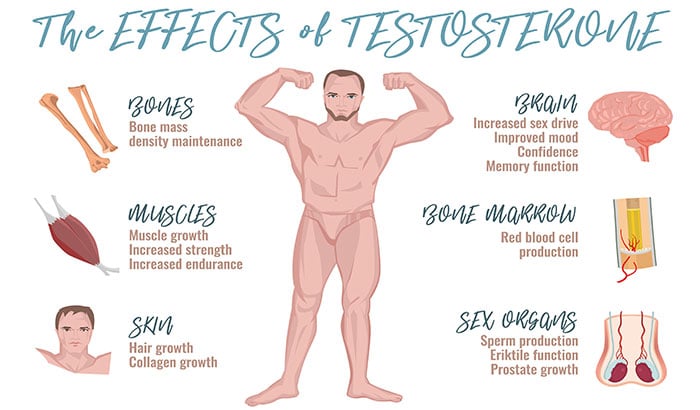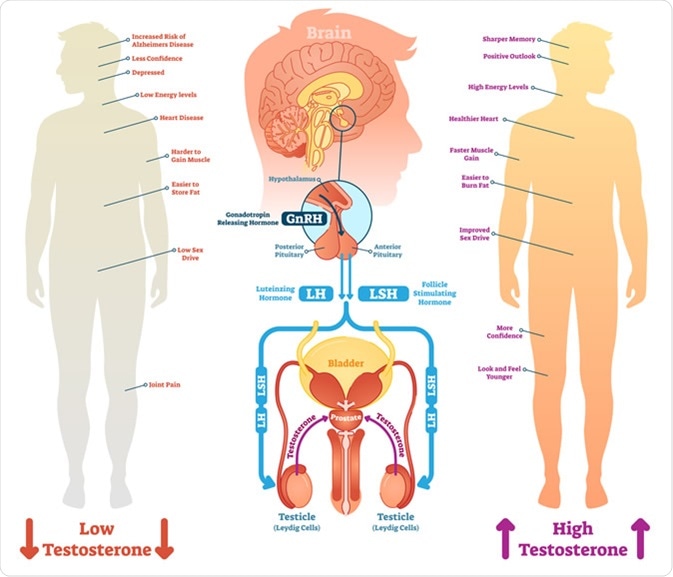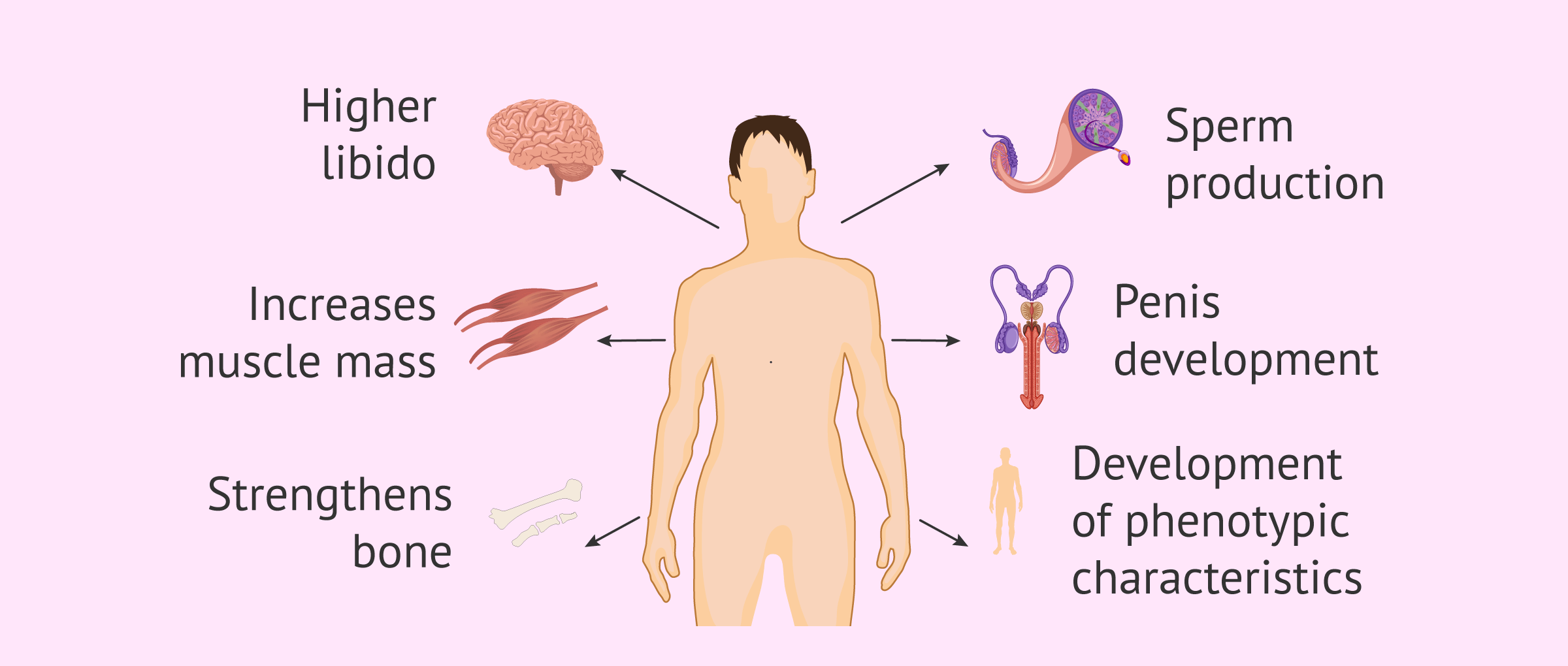Testosterone, the hormone responsible for many functions in the human body, has become a topic of discussion lately, with clinics offering testosterone therapy and individuals seeking to address low testosterone levels. In this article, we will explore what constitutes low testosterone, the signs and symptoms associated with it, and how it is diagnosed. We will also delve into the goals of testosterone replacement therapy and the importance of follow-up appointments with a healthcare professional to monitor hormone levels and make adjustments if necessary.
It is estimated that up to 25% of males receiving testosterone therapy have never undergone an initial testosterone test, highlighting the need for proper testing and diagnosis. Normal testosterone levels range from 300 to 1000 nanograms per deciliter in males, and 15 to 70 nanograms per deciliter in females. Signs and symptoms of low testosterone include reduced lean muscle mass, obesity, fatigue, decreased libido, and erectile dysfunction. Testosterone replacement therapy aims to raise testosterone levels to 450-600 nanograms per deciliter and improve these symptoms. Monitoring symptoms and hormone levels through follow-up appointments is vital to guiding treatment continuation and adjustments.

Production of Testosterone
Testosterone production in the testes
Testosterone, a hormone primarily responsible for male characteristics, is produced in the testes. The production of testosterone in the testes is regulated by a complex interplay between the hypothalamus and the pituitary gland. The hypothalamus secretes a hormone called gonadotropin-releasing hormone (GnRH), which stimulates the pituitary gland to produce luteinizing hormone (LH) and follicle-stimulating hormone (FSH). LH acts on the Leydig cells in the testes, triggering the production and secretion of testosterone.
Testosterone production in the adrenal glands
Apart from the testes, testosterone is also produced in smaller quantities in the adrenal glands. The adrenal glands are located on top of the kidneys and play a crucial role in hormone production. The adrenal cortex, the outer region of the adrenal glands, produces a variety of hormones, including testosterone. However, the adrenal glands contribute only a small fraction of total testosterone production, with the majority being synthesized in the testes.
Normal Testosterone Levels
Testosterone levels in males
In males, normal testosterone levels can vary depending on age. During puberty, testosterone levels surge, reaching their peak in the late teens or early twenties. In adult males, the normal range of testosterone levels typically falls between 300 and 1000 nanograms per deciliter (ng/dL). However, it is important to note that testosterone levels can fluctuate throughout the day, with the highest levels usually observed in the morning.
Testosterone levels in females
Females also produce testosterone, but in much smaller amounts compared to males. The normal range of testosterone levels in females is significantly lower, typically ranging between 15 and 70 ng/dL. It is important to maintain the right balance of testosterone in females, as both excess and deficiency can have undesirable effects on health.

Diagnosing Low Testosterone
Multiple tests for diagnosing low testosterone
Diagnosing low testosterone involves multiple tests to accurately assess the hormone levels in the body. The most common test is a blood test that measures the total testosterone levels. However, a single blood test may not provide a complete picture as testosterone levels can vary throughout the day. Therefore, multiple blood tests may be conducted, and free testosterone levels and other related hormones may also be measured to make an accurate diagnosis.
Signs and symptoms associated with low testosterone
Low testosterone can manifest in various signs and symptoms. These can include reduced lean muscle mass, obesity, reduced energy and fatigue, diminished work and physical performance, reduced body hair, cognitive dysfunction, depression, decreased libido, and erectile dysfunction. If an individual experiences a combination of these symptoms, it is important to seek medical advice and consider getting testosterone levels tested.
Signs and Symptoms of Low Testosterone
Reduced lean muscle mass
One of the prominent signs of low testosterone is reduced lean muscle mass. Testosterone plays a crucial role in maintaining and building muscle mass. When testosterone levels decline, muscle mass can diminish, leading to decreased strength and physical performance. Strength training and exercise can help increase muscle mass and mitigate the effects of low testosterone.
Obesity
Low testosterone levels can also contribute to obesity. Testosterone aids in regulating metabolism and fat distribution in the body. When testosterone is deficient, the body may have difficulty managing fat, leading to increased accumulation of visceral fat. This abdominal fat can increase the risk of various health issues such as cardiovascular disease and diabetes.
Reduced energy and fatigue
Another common symptom of low testosterone is reduced energy and constant fatigue. Testosterone contributes to overall energy levels, and a deficiency can result in persistent tiredness. Individuals with low testosterone may experience a lack of motivation, decreased productivity, and an overall feeling of lethargy.
Diminished work and physical performance
Low testosterone can have a significant impact on work and physical performance. It can lead to decreased strength, reduced endurance, and difficulties in maintaining focus and concentration. Tasks that were previously manageable may become more challenging, affecting productivity and overall performance.
Reduced body hair
Testosterone influences the growth of body hair, including facial hair in males. Low testosterone levels can result in reduced body hair growth or even hair loss. This can be particularly distressing for individuals who value their facial or body hair as a part of their identity.
Cognitive dysfunction
Testosterone also plays a role in cognitive function, including memory and mental clarity. Low testosterone levels can contribute to cognitive dysfunction, including difficulties with memory, focus, and concentration. This can impact daily activities and overall quality of life.
Depression
Depression is often associated with low testosterone levels. Testosterone contributes to mood regulation, and a deficiency can lead to feelings of sadness, irritability, and a general loss of interest in activities. Treating low testosterone through testosterone replacement therapy (TRT) can potentially alleviate depressive symptoms and improve overall well-being.
Decreased libido
One of the most commonly recognized symptoms of low testosterone is a decreased libido or sex drive. Testosterone plays a key role in maintaining sexual desire and arousal. When testosterone levels decline, individuals may experience a reduced interest in sex and difficulties in achieving or maintaining erections.
Erectile dysfunction
Low testosterone levels can contribute to erectile dysfunction (ED). Testosterone plays a crucial role in regulating blood flow to the penis and maintaining proper erectile function. When testosterone is deficient, individuals may experience difficulties in achieving or maintaining erections, leading to sexual performance issues.

Testosterone Replacement Therapy (TRT)
Initiating TRT based on diagnostic criteria
Testosterone replacement therapy (TRT) is a potential treatment option for individuals diagnosed with low testosterone levels. Before initiating TRT, it is important to meet specific diagnostic criteria, such as low testosterone levels confirmed by multiple blood tests and the presence of symptoms associated with low testosterone. It is crucial to consult with a healthcare professional to determine if TRT is appropriate and safe.
Realistic expectations of TRT
TRT can potentially address the symptoms associated with low testosterone, but it is important to have realistic expectations. TRT may not completely reverse certain effects of low testosterone, such as infertility or testicular atrophy. However, it can significantly improve quality of life by alleviating symptoms like fatigue, decreased libido, and depression.
Goal of TRT – raising testosterone levels
The goal of TRT is to raise testosterone levels within the normal range for the individual’s age and sex. The specific target range may vary depending on factors such as the individual’s age, overall health, and the severity of symptoms. It is important to work closely with a healthcare professional to determine the appropriate dosage and monitor testosterone levels regularly.
Importance of lowest effective dose
When undergoing TRT, it is essential to use the lowest effective dose to achieve the desired results. Using higher doses can increase the risk of potential side effects and may not necessarily lead to better outcomes. Striking the right balance between symptom relief and avoiding unnecessary risks is crucial in TRT.
Target range of testosterone levels
The target range for testosterone levels during TRT may vary depending on the individual’s circumstances. For most adult males, a target range of 400 to 800 ng/dL is generally considered appropriate. However, it is important to note that every individual is unique, and the target range may be adjusted based on specific needs and response to treatment.
Discontinuing TRT if no improvement
If an individual does not experience significant improvement in symptoms after starting TRT, it may be necessary to re-evaluate the treatment plan. In some cases, discontinuing TRT may be considered if the therapy does not provide the expected benefits. It is important to closely monitor the response to treatment and consult with a healthcare professional for guidance.
Individual cases of going above recommended range
In certain cases, such as specific medical conditions or individual response, testosterone levels may need to be raised above the recommended range temporarily. However, this should only be done under the supervision of a healthcare professional. Raising testosterone levels above the recommended range without proper medical guidance can increase the risk of side effects and potential health complications.
Monitoring response to testosterone therapy
Regular monitoring is essential when undergoing testosterone therapy. This includes follow-up blood tests to ensure testosterone levels remain within the target range and to assess the response to treatment. It is important to communicate any changes in symptoms or concerns to the healthcare professional to guide adjustments in the treatment plan.
Lack of follow-up appointments after TRT initiation
Unfortunately, some individuals may neglect follow-up appointments after initiating TRT. Regular follow-up visits are crucial to monitor hormone levels, assess symptoms, and make necessary adjustments to the treatment plan. Failing to attend follow-up appointments can hinder the effectiveness of TRT and potentially lead to undesirable outcomes.
Importance of Follow-Up Appointments
Cruciality of follow-up appointments
Follow-up appointments play a vital role in ensuring the efficacy and safety of any medical treatment, including TRT. They allow healthcare professionals to monitor the progress of treatment, evaluate any changes in symptoms, and make adjustments as necessary. Regular follow-up appointments provide an opportunity to address any concerns or questions that may arise during the course of treatment.
Monitoring hormone levels
Follow-up appointments enable healthcare professionals to monitor hormone levels and ensure they remain within the target range. Regular blood tests allow for a comprehensive evaluation of testosterone levels, which is crucial in determining the effectiveness of the treatment. Monitoring hormone levels also helps identify any potential imbalances or issues that may require further attention.
Adjusting dosage if necessary
Follow-up appointments provide an opportunity to assess the dosage of testosterone therapy. If symptoms persist or new ones arise, healthcare professionals can evaluate the need for adjusting the dosage. Monitoring the effects of treatment and optimizing the dosage is crucial to achieve the desired therapeutic outcomes and minimize the risk of side effects.
Guiding continuation of treatment through monitoring symptoms
Regular follow-up appointments enable healthcare professionals to monitor symptoms and evaluate the overall response to treatment. Monitoring changes in symptoms allows for a holistic assessment of the treatment plan and helps guide the decision of whether to continue, modify, or discontinue TRT. Open communication between the patient and healthcare professional is essential in determining the most appropriate course of action.
Benefits of regular follow-up
Regular follow-up appointments offer several benefits to individuals undergoing TRT. They provide a platform for open communication, allowing patients to address any concerns or questions they may have. Regular monitoring ensures that treatment remains optimized and tailored to the individual’s specific needs. Additionally, these appointments offer an opportunity for healthcare professionals to educate patients on lifestyle modifications and strategies to enhance the effectiveness of treatment.

Conclusion
Testosterone plays a crucial role in the human body, affecting various aspects of physical and mental health. Maintaining normal testosterone levels is essential for overall well-being and optimal functioning. If low testosterone is diagnosed, testosterone replacement therapy (TRT) can be a viable treatment option to alleviate symptoms and improve quality of life. However, regular monitoring and follow-up appointments are essential to ensure the safety and efficacy of TRT. Furthermore, regular check-ins with healthcare professionals are beneficial not only for TRT but also for any medical treatment. Additionally, platforms like Brilliant.org offer a valuable opportunity for individuals to enhance their knowledge and skills in subjects such as math, science, and computer science. With its diverse course offerings and user-friendly interface, Brilliant.org is an excellent resource for lifelong learning. Despite the different contexts, both TRT and online learning platforms underscore the significance of regular monitoring, follow-up, and engagement to achieve the best possible outcomes and promote personal growth and development.

